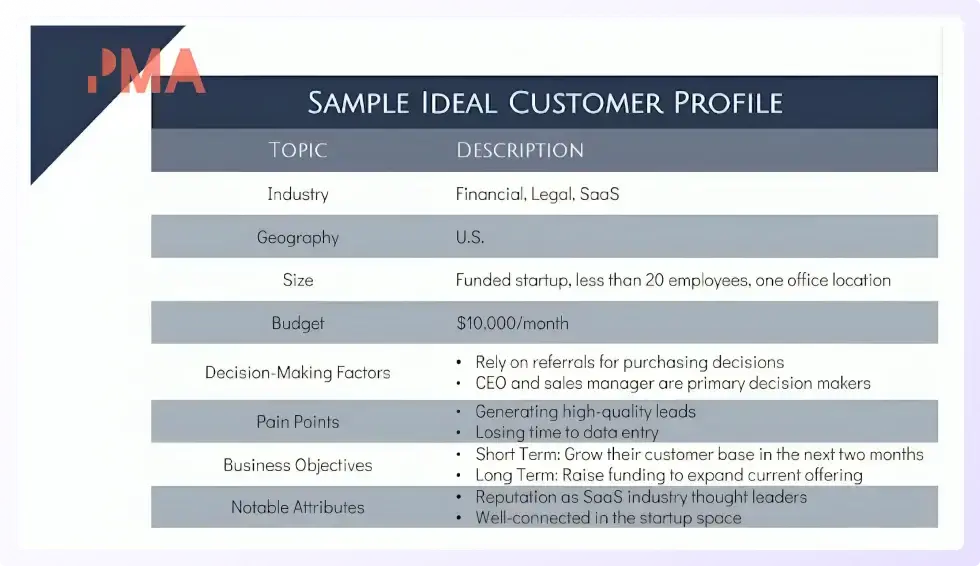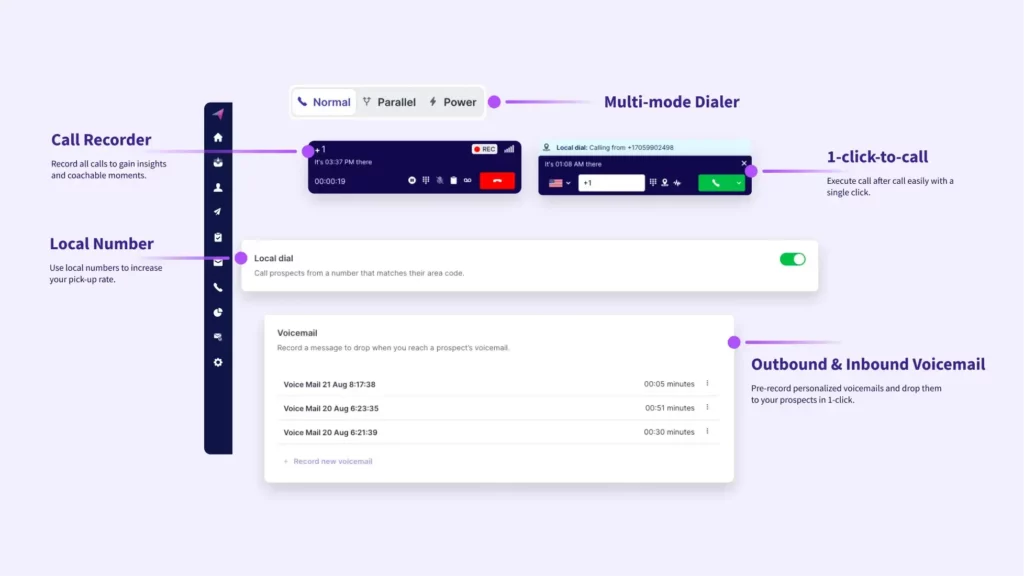Contrary to popular belief, cold calling is still one of the best outbound channels.
It puts you in direct contact with your prospects and helps you build a one-on-one relationship.
But most sales teams struggle with call connect rates because their prospecting lists have incorrect, invalid, or outdated phone numbers — which not only wastes a sales rep’s time but also leads to frustration and low morale.
You struggle to reach your ideal buyers and fall short of your quotas.
That’s why having the right contact information is crucial.
“But how can I do that?”
Enter: Cold calling database.
Let’s explore what a cold calling database is in detail below.
What Is a Cold Calling Database?
A cold calling database is a collection of contact information, potential prospects, or leads that a sales team can use to make cold calls. This database typically includes details like names, phone numbers, and email addresses, as well as additional information like job titles, company names, and industry information.
Sales or marketing teams use cold-calling databases to identify and reach out to prospects who may be interested in their products or services.
Why Is Cold Calling Database Important?
A cold-calling database serves as the foundation of your outbound efforts. To effectively sell your products or services, it is important to have contact information for potential leads. A well-maintained database comes in handy as it ensures that you reach out to the right people with the right message — tipping the scales in your favor and ensuring that you reach your cold-calling targets.
Here are 5 reasons why you need to have a cold calling database:
1. Enables You to Execute Targeted Outreach
While operating within the B2B industry, your audience tends to be niche. So, to sell your product or service, you need to have a specific set of contacts to reach out to your target audience.
With a B2B cold-calling database, sales teams can target certain demographics, industries, or job titles that are much more likely to consider purchasing your solution. By focusing efforts on these high-value leads, sales teams can ensure they are closing deals faster and more efficiently.
2. Saves Hours on Manual Work
Building a cold calling database involves compiling and organizing contact information for potential customers. Without a database, sales reps would spend a significant amount of their day researching and finding these details for each lead individually.
Picture this: the average cold calling connect rate is 2%. For every 100 prospects contacted, only 2 pick up the phone. This means sales reps have to research and find 100 individual contacts per day.
With a cold calling database, your sales team saves tons of time in research, ensuring more dials and increased connect rates.
3. Promotes Consistent Outreach
A well-maintained cold calling database ensures that sales teams always have a list of leads to contact, which is important for a steady flow of customers.
Additionally, a cold calling list will help reps keep pace while on a cold calling spree. As calls are cued one after the other, sales reps face little to no downtime between calls, thus increasing efficiency and productivity.
4. Manage Prospect Data Efficiently
Cold calling databases to store contact information, track lead engagements, record call results, and keep essential comments and details.
This data management aspect is essential when evaluating the efficacy of sales outreach methods, identifying areas for improvement, and making informed choices about future outreach. By tracking this data, sales teams may adjust their strategy and increase their overall success.
5. Scale Your Cold Calling Efforts
As a business grows, its cold calling needs may also increase. A well-designed cold-calling database can easily scale to accommodate more leads and support a larger sales team.
A database can support business growth and ensure sales teams have the resources they need to succeed by providing a scalable solution.
Build a Cold Calling Database in 4 Steps
Most sales teams buy a list, make a few calls, and call it a day. But this method almost never leads to success. And for a good reason!
The world has evolved. When was the last time you appreciated a cold call? Not only are they intrusive, but also they could put your prospects in a bad mood. Now imagine calling the wrong person to sell the wrong product. Nightmare.
That’s why it’s important to spend a few minutes carefully curating your cold call database.
Now we know what you may be thinking: isn't it counterintuitive to build an entire list when we’re trying to save time? Well, this is time well-utilized because:
- You’re actually going to get contacts of your ICPs
- You only have to do this once
That said, let’s unravel how to create the perfect B2B cold calling database.
Step 1: Define Your Target Audience
As with all things in sales, your customers are everything. This means you need to understand exactly who they are, what they do, and what challenges they face. List down these key elements to form your ideal customer profile (ICP):
- Industry
- Company
- Job title
- Location
- Company size
This will help you focus your efforts on finding leads that are more likely to benefit from your product or service.
Here’s a sample Ideal Customer Profile for your reference:

Source: Product Marketing Alliance
Step 2: Gather Contact Information
Once your ICP template is ready, it’s time for some digging.
Here are some best practices for researching your prospects:
- Scour the Internet for prospects who fit your ICP description.
- Use online resources such as company websites, industry directories, and social media platforms to gather contact information for potential leads.
- Look for key decision-makers within the companies you're targeting, such as CEOs, CTOs, or department heads.
Step 3: Employ Sales Prospecting Tools
There are several lead generation software options available that automate the process of finding your prospect's contact information. These tools come with filters that allow you to narrow down your search to your specific target audience, saving you a significant amount of time compared to manual prospecting.
One advantage of lead generation tools is that they allow you to “enrich” your data. This means any outdated information will be replaced with new and accurate data, saving you tons of dial time and increasing the chances of your call going through!
After you've compiled your list of leads using these tools, you can export them as .csv or Excel files for easy access.
When choosing lead generation software, look for options that provide a data guarantee and allow you to validate your data before making a purchase.
Step 4: Bring Chaos in Order With CRMs
Once you've gathered contact information for your leads, upload them into your customer relationship management (CRM) software for easy organization.
CRMs are your single source of truth, and it’s vital to keep all customer information easily accessible in one single place.
Moreover, CRMs allow you to easily segment your leads based on industry, company size, or job title. You can tailor your cold-calling scripts and messages by segmenting your leads to better resonate with each group. For example, if you’re selling a healthcare app, you can tailor your messaging based on different healthcare policies in different countries.
3 Tips To Get the Most Out of Your Cold Calling Database
Just like how you need to change the oil regularly, rotate the tires, and check the brakes of your car to keep it running smoothly and avoid problems, you also need to regularly clean up duplicate entries and update contact information in your database to keep it working well and avoid issues in your outreach efforts.
To make the most out of your database, follow the three tips listed below:
1. Clean up Your List
Your list may contain some misspelled words, partial phone numbers, incorrect zip codes or states without zipcodes, first names without last names, and so on. (This is why lead enrichment is essential, by the way!)
Scan through lists and find anomalies. Delete duplicate records and maintain a consistent format throughout.
For example, the VP of Sales and the Vice President of Sales mean the same thing. So pick one and normalize it across all records.
Additionally, it’s important to note if all phone numbers have their country or area codes.
2. Update Your Database Regularly
Your prospect’s designation may change at any time. They may leave an organization to join a new one. New hires replace old ones. Internal promotions and changing of departments are regular phenomena.
Your prospect may also change their contact information.
As a sales rep, it’s crucial that you contact the right people with the right information.
This is why you must keep your database updated periodically, say every three months or so. Regularly reviewing and updating your database ensures that you have access to the most relevant information, improving the effectiveness of your sales outreach efforts.
3. Consolidate Your Data
Keeping all your customers in one central and accessible place will save you time and effort. This is where your CRM plays a significant role.
CRMs have features to differentiate between prospect, lead, and customer and let you keep track of all communication through the different stages of the sales process. With a consolidated database, you can segment leads more effectively and tailor your approach, leading to higher success rates. Additionally, streamlined reporting and analysis help you track key metrics and optimize your cold calling strategy.
As Stewart Rogers says in the book Lessons from 100,000 Cold Calls, “The number of top-quality prospects is limited, and you only have so much time to chase them. Get organized! Consolidate all your data into one source with a consistent format, clean it up, and keep it updated.”
The Right Tool for The Perfect Cold Calling Database

Creating a high-quality prospect list is the initial and crucial step in developing a successful outbound sales strategy. A strong foundation sets the stage for success and is difficult to undermine.
However, this process presents its challenges:
- Wasting hours searching for ideal Ideal Customer Profiles (ICPs)
- Low connection rates due to poor-quality contact numbers
- Inability to research multiple prospects within the same company
Unfortunately, all your efforts may go to waste if you are unable to generate results from your list.
That’s why employing the right platform is crucial! Luckily, we know what you need: Prospect IQ + Klenty’s Sales Dialer.
Prospect IQ is a B2B prospecting data platform that houses over 220M+ contacts and helps you:
- Filter prospects based on company name, industry, department, revenue size, technologies used, domain name, and so on
- Save your “ICP” or “Best Customer Lookalikes” as Views that can be readily accessed
- Target prospects with unique needs based on demographics, geographic, or technographic data
- Execute a set of personalized activities as soon as you get your hands on their contact data
- Sync all information back to your CRM to keep an updated system of record
The best part? Prospect IQ’s “Waterfall Model” enhances lead enrichment. Prospect IQ screens over 10+ data providers instead of single-source data platforms and surfaces the best-fit customer information.
After you’ve spent time and effort building your cold-calling database, you’d want to make the best use of it.
This is where Klenty’s Multi-mode Sales Dialer comes in!
- Parallel Dialer lets you dial 5 prospects at the same time
- Power Dialer lets you blitz through calls without manual interference
- Normal Dialer is best for making one-off calls
- CRM Dialer enables you to make quick calls from a contact record within your favorite CRM
Curious to know more? Contact us to get a tailored demo now!

